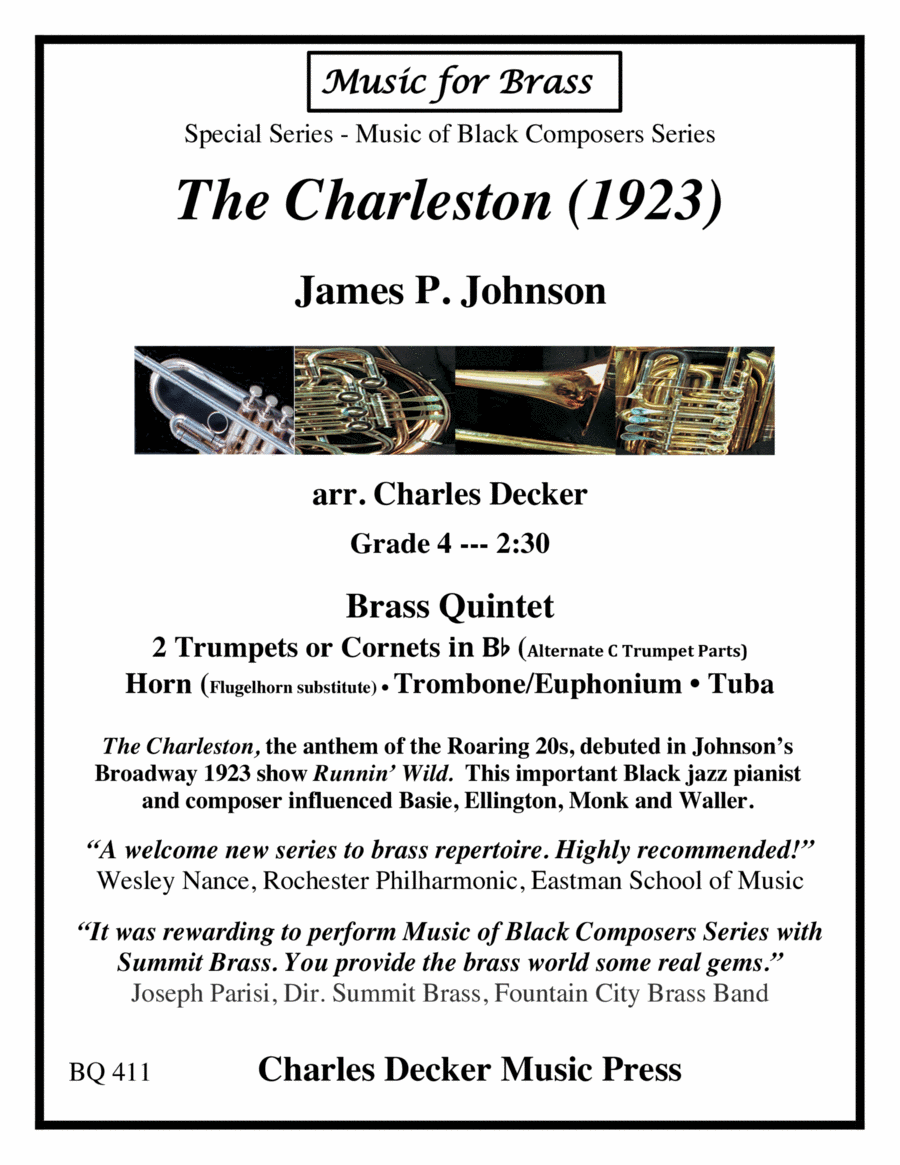Brass Quintet Cornet,Euphonium,Flugelhorn,Trombone,Trumpet,Tuba - Level 3 - Digital Download SKU: A0.1276031 Composed by James P. Johnson. Arranged by Charles Decker. 20th Century,Broadway,Film/TV,Musical/Show,Pop,Ragtime. 21 pages. Charles Decker Music Press #867780. Published by Charles Decker Music Press (A0.1276031). From the Music of Black Composers Series at Charles Decker Music Press is the âThe Charlestonâ which debuted in James P. Johnsonâs Broadway 1923 show âRunninâ Wildâ to become the wildly popular and unofficial anthem of the Roaring 20âs.  An important jazz pianist and composer, Johnson was a major influence on Count Basie, Duke Ellington, Art Tatum, Thelonious Monk, and Fats Waller.  Arranged for a brass quintet of two B-flat trumpets with alternate C trumpet parts, horn in F with a substitute flugelhorn part, trombone or euphonium and tuba, the arrangement uses the original 1923 piano edition and retains the style of the day. The recording is of the entire edition.âThe Music of Black Composers Series is a welcome and timely addition to the brass repertoire. Interesting music, expertly arranged, fun to perform, and well received by audiences. These pieces are now permanently in my quintet book and I will be using them with my student groups as well. Highly recommended!â  Wesley Nance, Rochester Philharmonic Orchestra, Eastman School of Music âI was so pleased to see the great works arranged for brass ensemble by Charles Decker Music Press especially the Music of Black Composersâ Series. It was especially rewarding to perform several of these with Summit Brass and with the students attending the Rafael Mendez Brass institute. Please keep these wonderful settings coming. You have provided the brass world with some real gems.â Joseph Parisi, Director Summit Brass, FountainCity Brass Band, University of Missouri Kansas City Conservatory Wind EnsembleThe Interlochen Arts Academy and the University of Denver have purchased the Music of Black Composer Series with Charles Decker Music Press and the summer Rafael Mendez Brass Institute and Eastman School of Music uses the series arrangements in their chamber and brass ensembles music programs. See 50+ homogeneous brass editions for trumpet, horn and trombone ensembles and 75+ mixed brass ensemble publications with Charles Decker Music Press at Sheet Music Plus for inexperienced to advanced musicians with music ranging from the Renaissance to contemporary new works for trios, quartets, quintets, brass choir and brass band. Many of the mixed brass ensemble editions include alternate and substitute parts being alternate C trumpet parts for B-flat trumpet parts, flugelhorn/trumpet substitute for horn, horn substitute for trombone and treble clef euphonium substitute for trombone. To see our Music of Black Composers Series enter âBlack Composers Seriesâ in the search box at Charles Decker Music Press for 25 arrangements for mixed brass ensembles ranging from early jazz to symphonic works with composers Samuel Coleridge-Taylor, R. Nathaniel Dett, William Grant Still, Will Marion Cook, James Reese Europe, James Johnson and others.For more brass quintet editions by Charles Decker use these links to Kendor Music and Cherry Classics Music for listings of my arrangements of music by J.S. Bach, H.L. Clarke, Debussy, Dukas, Elgar, Falla, Holst, Ives, Nestico, Rachmaninoff, Satie, and Tchaikovsky.
